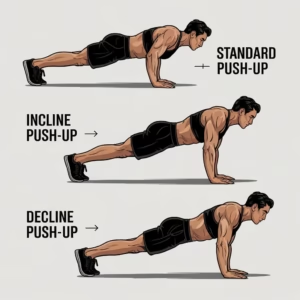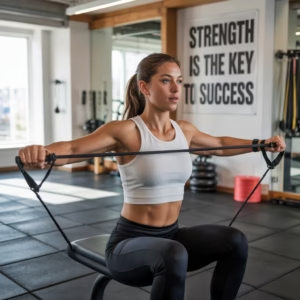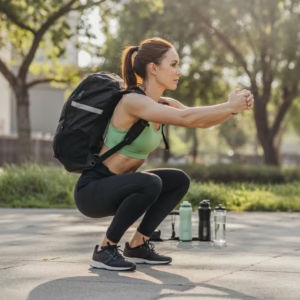Who says you need a gym membership to build muscle? Whether you’re short on time, traveling, or just prefer working out at home, there are plenty of effective ways to gain strength and size without stepping foot in a gym. From bodyweight exercises to resistance bands and nutrition strategies, you can achieve real results with minimal equipment. In this post, we’ll explore seven science-backed methods to help you pack on muscle—no gym required!
Introduction
Building muscle doesn’t have to be confined to the walls of a gym. With the right approach, you can effectively increase your strength and muscle mass from the comfort of your home or outdoors. Bodyweight exercises and home workouts are not only convenient but also highly effective for muscle building. Engaging in these activities can lead to numerous benefits, including improved metabolism, enhanced physical appearance, and increased overall health.
Build muscle without a gym
1. Bodyweight Exercises
1.1 Push-Ups
Push-ups are a classic bodyweight exercise that targets the chest, shoulders, and triceps.

- Variations:
- Standard Push-Ups: Hands shoulder-width apart, body in a straight line.
- Incline Push-Ups: Hands elevated on a surface, easier for beginners.
- Decline Push-Ups: Feet elevated, increasing difficulty.
- Proper Form and Technique: Keep your body straight from head to heels, engage your core, and lower your body until your chest nearly touches the ground.
- Progression Tips: Start with incline push-ups if you’re a beginner, then move to standard, and finally to decline push-ups as you build strength.
1.2 Pull-Ups
Pull-ups are excellent for developing upper body strength, particularly in the back and biceps.

- Different Grips and Their Effects:
- Overhand Grip: Targets the back more.
- Underhand Grip: Engages the biceps more effectively.
- Modifications for Beginners: Use a resistance band for assistance or perform negative pull-ups by jumping up and slowly lowering yourself down.
- Incorporating Pull-Ups into a Routine: Aim for 3 sets of as many reps as you can manage, gradually increasing your reps as you get stronger.
1.3 Squats
Squats are fundamental for building lower body strength.
- Types:
- Bodyweight Squats: Feet shoulder-width apart, lower your body as if sitting back into a chair.
- Jump Squats: Add a jump at the top for explosive power.
- Pistol Squats: A challenging single-leg squat for advanced practitioners.
- Importance of Form and Depth: Ensure your knees do not extend past your toes and aim for thighs parallel to the ground for maximum effectiveness.
- Tips for Adding Resistance: Use a backpack filled with books or water bottles to increase the load.
Weight Loss Drinks from Explorehealthwellness
2. Resistance Bands
2.1 Types of Resistance Bands
Resistance bands are versatile tools for strength training.

- Overview of Different Bands:
- Loop Bands: Great for lower body exercises.
- Tube Bands: Ideal for upper body workouts.
- Therapy Bands: Used for rehabilitation and light resistance.
- Choosing the Right Resistance Level: Start with a lighter band to master the form, then progress to heavier bands as you gain strength.
- Benefits of Using Bands for Muscle Building: They provide constant tension throughout the movement, which can enhance muscle engagement.
2.2 Effective Band Exercises
Incorporating resistance bands into your routine can diversify your workouts.
- Key Exercises:
- Rows: Great for back muscles.
- Chest Presses: Targets the chest and triceps.
- Leg Extensions: Focuses on the quadriceps.
- Setting Up a Resistance Band Workout: Choose 3-4 exercises, perform 3 sets of 10-15 reps for each.
- Tips for Maximizing Effectiveness: Focus on slow, controlled movements to enhance muscle engagement.
2.3 Incorporating Bands into a Routine
Creating a structured workout plan with bands can yield great results.
- Sample Workout Plans: Combine band exercises with bodyweight movements for a full-body workout.
- Frequency and Duration Recommendations: Aim for 2-3 sessions per week, lasting 30-45 minutes each.
- Combining Bands with Bodyweight Exercises: Alternate between band exercises and bodyweight movements for balanced training.
3. Household Items as Weights
3.1 Common Household Items

You can use everyday items to add resistance to your workouts.
- Examples: Water bottles, backpacks filled with books, or even furniture like chairs for support.
- Safety Considerations: Ensure items are stable and secure to prevent injury.
- Creative Ways to Add Resistance: Use a filled backpack for squats or lunges, or water bottles for shoulder presses.
3.2 Exercises Using Household Items
Household items can be effectively integrated into your workout routine.
- Key Exercises:
- Deadlifts: Use a backpack for added weight.
- Overhead Presses: Use water bottles for resistance.
- Lunges: Hold a backpack for added intensity.
- Ensuring Proper Form: Focus on maintaining good posture and alignment, even with makeshift weights.
- Tips for Increasing Intensity: Gradually increase the weight of the items you use or increase the number of repetitions.
3.3 Structuring Workouts with Household Items
Creating a balanced workout routine is essential.
- Sample Workout Routines: Combine exercises targeting different muscle groups for a comprehensive workout.
- Balancing Different Muscle Groups: Ensure you include exercises for both upper and lower body.
- Frequency and Progression Strategies: Aim for 3-4 workouts per week, gradually increasing the weight or reps as you progress.
4. Outdoor Workouts
4.1 Utilizing Natural Terrain
Outdoor workouts can be refreshing and effective.

- Benefits of Outdoor Workouts: Fresh air and natural scenery can enhance motivation and enjoyment.
- Exercises: Incorporate hill sprints, use park benches for step-ups, or find stairs for a challenging workout.
- Safety Tips: Be aware of your surroundings and choose safe locations for your workouts.
4.2 Group Activities
Engaging in group activities can enhance your fitness journey.
- Community Sports or Group Classes: Look for local sports leagues or fitness classes in parks.
- Benefits of Social Interaction: Working out with others can boost motivation and accountability.
- Finding Local Outdoor Workout Groups: Use social media or community boards to find groups near you.
4.3 Seasonal Considerations
Adapting your workouts to the seasons can keep things interesting.
- Adapting Workouts to Different Weather Conditions: Embrace the outdoors in all seasons, whether it’s running in the summer or snowshoeing in the winter.
- Seasonal Exercises: Explore activities like hiking in the fall or swimming in the summer.
- Staying Motivated Throughout the Year: Set seasonal goals to keep your fitness journey exciting.
5. Nutrition and Recovery
5.1 Importance of Nutrition
Nutrition plays a crucial role in muscle building.

- Key Nutrients for Muscle Building: Focus on protein for muscle repair, carbohydrates for energy, and healthy fats for overall health.
- Meal Planning Tips: Prepare balanced meals with a good mix of macronutrients to support your training.
- Hydration and Its Role in Recovery: Drink plenty of water to stay hydrated, especially during workouts.
5.2 Recovery Strategies
Recovery is just as important as the workout itself.
- Importance of Rest Days and Sleep: Allow your muscles time to recover and grow stronger.
- Techniques: Incorporate stretching, foam rolling, and active recovery days into your routine.
- Signs of Overtraining: Be aware of fatigue, decreased performance, and persistent soreness, and adjust your training accordingly.
5.3 Supplements and Alternatives
While whole foods should be your primary source of nutrients, some supplements can be beneficial.
- Overview of Common Supplements: Protein powders and creatine can support muscle growth when used appropriately.
- Natural Food Sources for Muscle Building: Focus on lean meats, legumes, nuts, and dairy for protein.
- When to Consider Supplements: If you struggle to meet your nutritional needs through food alone, consider consulting a healthcare professional.
Conclusion
Building muscle without a gym is entirely possible with the right strategies and mindset. By incorporating bodyweight exercises, resistance bands, household items, and outdoor workouts into your routine, you can achieve your fitness goals. Remember, consistency and patience are key in your muscle-building journey. Start today, and enjoy the process of becoming stronger and healthier.
FAQs
Can I really build muscle without a gym?Yes, with the right exercises and consistency, you can effectively build muscle without a gym.
How long will it take to see results?Results vary by individual, but with regular training and proper nutrition, you may start to see changes in 4-8 weeks.
What is the best way to track my progress?Keep a workout journal to log your exercises, sets, and reps, and take progress photos to visually track changes.
Are there any risks associated with bodyweight training?As with any exercise, improper form can lead to injury. Focus on technique and listen to your body.
How can I stay motivated to work out at home?Set specific goals, create a workout schedule, and consider joining online fitness communities for support and accountability.


1 thought on “7 Proven Ways to Build Muscle Without a Gym”